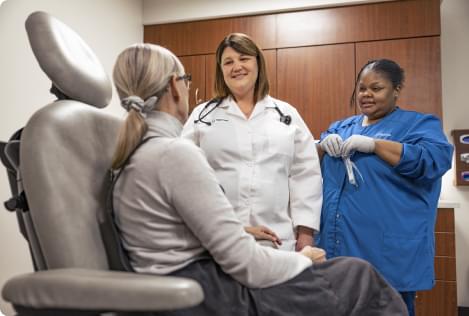Overview
HPV infection is a viral infection that commonly causes skin or mucous membrane growths (warts). There are more than 100 varieties of human papillomavirus (HPV). Some types of HPV infection cause warts, and some can cause different types of cancer.
Most HPV infections don't lead to cancer. But some types of genital HPV can cause cancer of the lower part of the uterus that connects to the vagina (cervix). Other types of cancers, including cancers of the anus, penis, vagina, vulva and back of the throat (oropharyngeal), have been linked to HPV infection.
These infections are often transmitted sexually or through other skin-to-skin contact. Vaccines can help protect against the strains of HPV most likely to cause genital warts or cervical cancer.
Symptoms
In most cases, your body's immune system defeats an HPV infection before it creates warts. When warts do appear, they vary in appearance depending on which kind of HPV is involved:
-
Genital warts. These appear as flat lesions, small cauliflower-like bumps or tiny stemlike protrusions. In women, genital warts appear mostly on the vulva but can also occur near the anus, on the cervix or in the vagina.
In men, genital warts appear on the penis and scrotum or around the anus. Genital warts rarely cause discomfort or pain, though they may itch or feel tender.
- Common warts. Common warts appear as rough, raised bumps and usually occur on the hands and fingers. In most cases, common warts are simply unsightly, but they can also be painful or susceptible to injury or bleeding.
- Plantar warts. Plantar warts are hard, grainy growths that usually appear on the heels or balls of your feet. These warts might cause discomfort.
- Flat warts. Flat warts are flat-topped, slightly raised lesions. They can appear anywhere, but children usually get them on the face and men tend to get them in the beard area. Women tend to get them on the legs.
Cervical cancer
Nearly all cervical cancers are caused by HPV infections, but cervical cancer may take 20 years or longer to develop after an HPV infection. The HPV infection and early cervical cancer typically don't cause noticeable symptoms. Getting vaccinated against HPV infection is your best protection from cervical cancer.
Because early cervical cancer doesn't cause symptoms, it's vital that women have regular screening tests to detect any precancerous changes in the cervix that might lead to cancer. Current guidelines recommend that women ages 21 to 29 have a Pap test every three years.
Women ages 30 to 65 are advised to continue having a Pap test every three years, or every five years if they also get the HPV DNA test at the same time. Women over 65 can stop testing if they've had three normal Pap tests in a row, or two HPV DNA and Pap tests with no abnormal results.

When to see a doctor
If you or your child has warts of any kind that cause embarrassment, discomfort or pain, seek advice from your doctor.
Causes
HPV infection occurs when the virus enters your body, usually through a cut, abrasion or small tear in your skin. The virus is transferred primarily by skin-to-skin contact.
Genital HPV infections are contracted through sexual intercourse, anal sex and other skin-to-skin contact in the genital region. Some HPV infections that result in oral or upper respiratory lesions are contracted through oral sex.
If you're pregnant and have an HPV infection with genital warts, it's possible your baby may get the infection. Rarely, the infection may cause a noncancerous growth in the baby's voice box (larynx).
Warts are contagious. They can spread through direct contact with a wart. Warts can also spread when someone touches something that already touched a wart.
Risk factors
HPV infections are common. Risk factors for HPV infection include:
- Number of sexual partners. The more sexual partners you have, the more likely you are to contract a genital HPV infection. Having sex with a partner who has had multiple sex partners also increases your risk.
- Age. Common warts occur mostly in children. Genital warts occur most often in adolescents and young adults.
- Weakened immune systems. People who have weakened immune systems are at greater risk of HPV infections. Immune systems can be weakened by HIV/AIDS or by immune system-suppressing drugs used after organ transplants.
- Damaged skin. Areas of skin that have been punctured or opened are more prone to develop common warts.
- Personal contact. Touching someone's warts or not wearing protection before contacting surfaces that have been exposed to HPV — such as public showers or swimming pools — might increase your risk of HPV infection.
Complications
- Oral and upper respiratory lesions. Some HPV infections cause lesions on your tongue, tonsils, soft palate, or within your larynx and nose.
- Cancer. Certain strains of HPV can cause cervical cancer. These strains might also contribute to cancers of the genitals, anus, mouth and upper respiratory tract.
Prevention
Common warts
It's difficult to prevent HPV infections that cause common warts. If you have a common wart, you can prevent the spread of the infection and formation of new warts by not picking at a wart and not biting your nails.
Plantar warts
To reduce the risk of contracting HPV infections that cause plantar warts, wear shoes or sandals in public pools and locker rooms.
Genital warts
You can reduce your risk of developing genital warts and other HPV-related genital lesions by:
- Being in a mutually monogamous sexual relationship
- Reducing your number of sex partners
- Using a latex condom, which can reduce your risk of HPV transmission
HPV vaccines
Gardasil 9 is an HPV vaccine approved by the U.S. Food and Drug Administration and can be used for males and females to protect against cervical cancer and genital warts.
The Centers for Disease Control and Prevention (CDC) recommends routine HPV vaccination for girls and boys ages 11 and 12, although it can be given as early as age 9. It's ideal for girls and boys to receive the vaccine before they have sexual contact and are exposed to HPV. Research has shown that receiving the vaccine at a young age isn't linked to an earlier start of sexual activity.
Once someone is infected with HPV, the vaccine might not be as effective or might not work at all. Also, response to the vaccine is better at younger ages than older ones. But, if given before someone is infected, the vaccine can prevent most cases of cervical cancer.
The CDC recommends that all 11- and 12-year-olds receive two doses of HPV vaccine at least six months apart. Younger adolescents ages 9 and 10 and teens ages 13 and 14 can also receive vaccination on the updated two-dose schedule. Research has shown that the two-dose schedule is effective for children under 15.
Teens and young adults who begin the vaccine series later, at ages 15 through 26, should continue to receive three doses of the vaccine.
The CDC recommends catch-up HPV vaccinations for all people through age 26 who aren't adequately vaccinated.
The U.S. Food and Drug Administration recently approved the use of Gardasil 9 for males and females ages 9 to 45. If you're age 27 to 45, discuss with your doctor whether he or she recommends that you get the HPV vaccine.
Diagnosis
Your doctor might be able to diagnose HPV infection by looking at your warts.
If genital warts aren't visible, you'll need one or more of the following tests:
- Vinegar (acetic acid) solution test. A vinegar solution applied to HPV-infected genital areas turns them white. This may help in identifying difficult-to-see flat lesions.
- Pap test. Your doctor collects a sample of cells from your cervix or vagina to send for laboratory analysis. Pap tests can reveal abnormalities that can lead to cancer.
- DNA test. This test, conducted on cells from your cervix, can recognize the DNA of the high-risk varieties of HPV that have been linked to genital cancers. It's recommended for women 30 and older in addition to the Pap test.
Treatment
Warts often go away without treatment, particularly in children. However, there's no cure for the virus, so they can reappear in the same place or other places.
Medications
Medications to eliminate warts are typically applied directly to the lesion and usually take many applications before they're successful. Examples include:
- Salicylic acid. Over-the-counter treatments that contain salicylic acid work by removing layers of a wart a little at a time. For use on common warts, salicylic acid can cause skin irritation and isn't for use on your face.
- Imiquimod. This prescription cream might enhance your immune system's ability to fight HPV. Common side effects include redness and swelling at the application site.
- Podofilox. Another topical prescription, podofilox works by destroying genital wart tissue. Podofilox may cause burning and itching where it's applied.
- Trichloroacetic acid. This chemical treatment burns off warts on the palms, soles and genitals. It might cause local irritation.
Surgical and other procedures
If medications don't work, your doctor might suggest removing warts by one of these methods:
- Freezing with liquid nitrogen (cryotherapy)
- Burning with an electrical current (electrocautery)
- Surgical removal
- Laser surgery
Treatment for HPV in the cervix
If you have an abnormal HPV or Pap test, your gynecologist will perform a procedure called a colposcopy. Using an instrument that provides a magnified view of the cervix (colposcope), your doctor will look closely at the cervix and take samples (biopsy) of any areas that look abnormal.
Any precancerous lesions need to be removed. Options include freezing (cryosurgery), laser, surgical removal, loop electrosurgical excision procedure (LEEP) and cold knife conization. LEEP uses a thin looped wire charged with an electric current to remove a thin layer of a section of the cervix and cold knife conization is a surgical procedure that removes a cone-shaped piece of the cervix.
Preparing for your appointment
You'll likely start by seeing your primary care provider. Depending on where your warts are located, you may be referred to a doctor who specializes in disorders of the skin (dermatologist), feet (podiatrist) or reproductive organs (gynecologist or urologist).
Here's some information to help you get ready for your appointment.
What you can do
Before your appointment, make a list of:
- Your symptoms, including any that seem unrelated to the reason for your appointment
- Key personal information, including major stresses, recent life changes and your sexual history
- All medications, vitamins or other supplements you take, including the doses
- Questions to ask your doctor
For HPV infection, questions to ask your doctor include:
- What's the most likely cause of my symptoms?
- Are there other possible causes?
- Do I need to have any tests?
- How can I prevent HPV infection in the future?
- Are there brochures or other printed material that I can have? What websites do you recommend?
Don't hesitate to ask other questions.
What to expect from your doctor
Your doctor is likely to ask you questions, such as:
- When did your symptoms begin?
- Are you in a monogamous sexual relationship? Is your partner?
- Where have you found lesions?
- Are the lesions painful or itchy?
- Does anything seem to improve your symptoms?
- What, if anything, appears to worsen your symptoms?
© 1998-2024 Mayo Foundation for Medical Education and Research (MFMER). All rights reserved. Terms of Use


